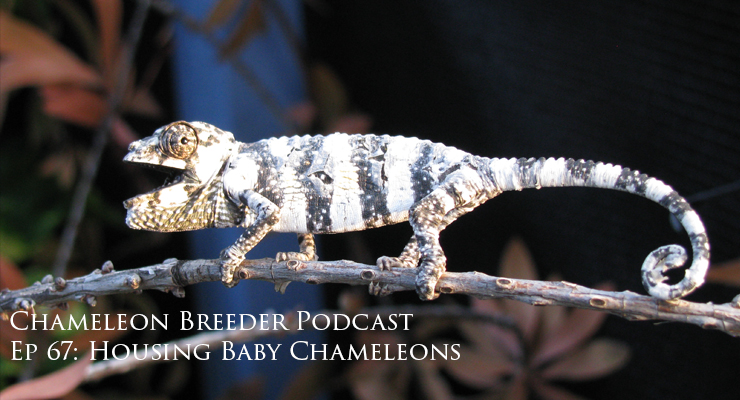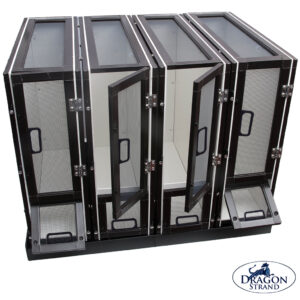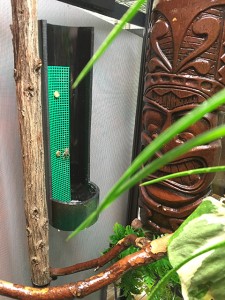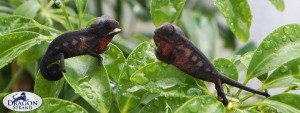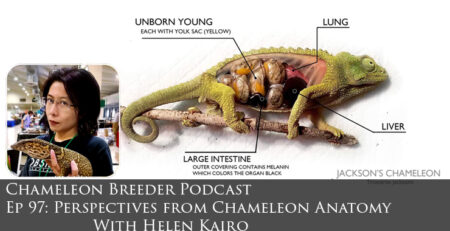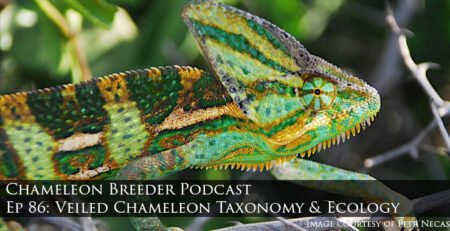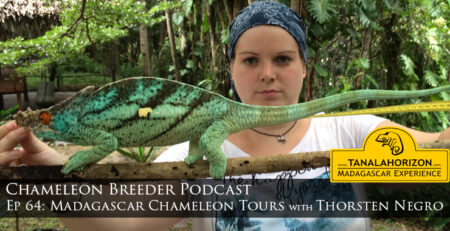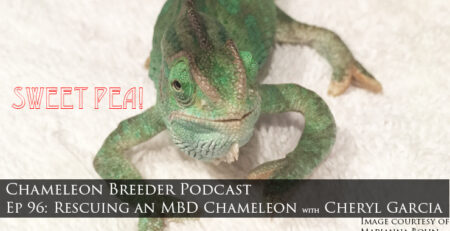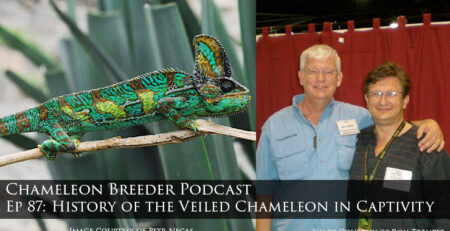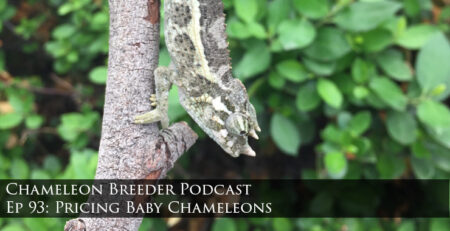Ep 67: Housing Baby Chameleons
In today’s episode we discussed a couple products. The first is the Dragon Strand Nursery Cage System. This was the industries first commercially available cage that catered specifically to chameleon breeders. The Nursery Cage System is designed to fit on a baker’s rack. Each set ordered comes with four individual cages and a drainage tray that the cages sit on. The Nursery Cages allow physical and visual isolation so babies can grow to their maximum potential. Click on the picture to learn more.
Nick Barta from Full Throttle Feeders has a version of the cricket run feeder that is a classy and professional version which looks good in a chameleon cage. Your an click on the picture and go to his website where you can contact him and ask for availability.
We discussed a study on baby chameleons being raised in groups vs individually. Find information on this study below:
To get a copy of the study in this article go to this link:
(This study requires a $35 payment for the study)
To view media coverage:
ABC Australia “Early Isolation Makes For a Dull Chameleon”
Wired.com “Lizards Needs Social Lives Too”
And if you are interested in a more in depth response to the study from my perspective click on the link below:
Transcript (more or less)
Hello, This is your host, Bill Strand. Today we are going to talk about a special passion of mine – raising baby chameleons. Specifically – different methods and philosophies on housing baby chameleons. Welcome to the Chameleon Breeder Podcast.
Good morning Chameleon wranglers! One of the greatest joys in keeping chameleons for me is raising up baby chameleons. When I as a grade school kid came down the stairs and found that my Jackson’s Chameleon had birthed babies I think I was hooked from that point on. Since then I have always had some involvement with chameleons…well, okay, except for a few years in the college dorm. We will refer to them as the dark ages. But as soon as I regained my freedom from those draconian house rules designed to repress my inner light and joy, the dining room became a free range and I was back with chameleons never to leave again. From this short story I can tell you that a free range is a pretty poor method for having Jackson’s Chameleons give live birth-especially when it happens while you are at work. But that is a story for another time. Housing chameleons and raising up babies became my special interest within this chameleon special interest. Today I am going to talk about 0 to 3 months old, for those wanting to breed chameleons, and I’ll talk to the keeper who is wanting to bring home their new 3 month or older baby chameleon.
I want to start by saying that setting up a cage for a baby chameleon is just like setting up a cage for an adult. You need to give them all the heat, humidity, UVB, and exposure gradients as you do an adult. You will have to scale your light strength to accommodate the smaller body mass – and that’s so you don’t overwhelm the little guy. Perhaps we should begin by a recap about gradients.
A gradient is the progression from one extreme to another. The first one, heat, is the easiest to understand this concept. If I have a heat lamp on the top right back corner then the temperature under that bulb may be 88 degrees and the temperature at the bottom left front may be 72. Assuming you have a suitable branch network you are allowing your chameleon to regulate his heat anywhere between 88 and 72 degrees. You can quickly see that the more choices we give our chameleon the better… as we do not know what they need at any given moment. They, of course, are the experts. It is their job to take care of themselves.. and its our job… to give them the tools… they need… to do it right. The second main gradient is humidity which ends up being more of pockets in space or time than a static linear progression. And by that I mean you can create a pocket of humidity under a hanging potted plant and some solid sides of a cage or else turning on the humidifier creates a high humidity time period. The heat is a linear progression because you can take a thermometer and chart out each degree of temperature drop and the progression stays as long as the bulb is on.
UVB is a static progression as well. A chameleon will soak up UVB until it’s body says that is has enough D3. And then it will want to retreat away from the UVB. Thus it is important to provide an escape either by having perching branches far enough away that the UVB reading is negligible or else providing hiding places such as plant leaves that block the UVB. Ideally, you provide both – especially because the last gradient is exposure. And this is the ability to hide and feel secure. Pay special attention to this one as this one goes against our human desire to see our chameleon on our schedule. If we give it a hiding place we may not see our chameleon on demand. And here is where we have to catch ourselves and realize that being able to hide when you do not feel safe is a psychological need in all animals. It is a need. If that need is not met then there is stress. Your chameleon will also equate its cage with insecurity and continually want to get out. Experienced chameleon keepers whimper whenever we read that someone’s chameleon loves them so much that they always want to get out of their cage to be with them. I have seen some exceptional individuals that I have to admit have lost all fear of humans and think they should be worshipped by these strange monkeys. But, the overwhelming odds are that you are misreading the situation if you think their behavior is driven by a human emotion that has no practical purpose in natural chameleon evolution. A love bond is beneficial to animals that have to raise their young or form social groups for survival. Chameleons do neither. Please carefully check each gradient if your chameleon looks or acts like he wants to get out of his cage. It could be many things including hunger, thirst, a draft, being scared of seeing your pet bird, or simply seeing your ceiling fan as a desirable higher perch. Start with the gradients and you can move on from there.
The first question people ask when getting a chameleon is often how big of a cage it needs. The true answer is that the minimum cage size for a baby or adult chameleon is one in which you can provide those gradients.
This is a function of how strong of a heat lamp or UVB light you use and how big of humidity pockets and hiding spaces you need to build. This is an important distinction to make because when it is said that Panther chameleons need a 2’ x 2’ x 4’ tall cage the implication is that you use the inside wisely. I have seen 4’ tall cages with a two foot tall plant in the center and a little vine strung up in the top half. The chameleon could be seen crawling around and around the cage walls getting his “exercise”. A large cage can be set up poorly and a small cage can be set up effectively. The winning combination is getting a cage twice the size of your minimum cage size and decorate the inside smartly. But if there is anything you come away with from this podcast, it is that the minimum cage size should be based on how much space it takes to create your gradients. Of course, the chameleon size dictates how much space your gradients must take for the body to fit in them, but it isn’t just how far away from each other the cage walls are that is important.
Now here is where I am going to go out on a limb. When people purchase a baby chameleon – often at the three month mark – the advice is usually given that they should be grown up in a smaller cage and then, when they are adult, graduate to their final large size adult cage. I am going to suggest to you that you just get the adult cage for your three month baby.
A large cage will not harm or stress your baby chameleon. You can actually put a hatchling chameleon in a 4’ cage from day one and it will be the happiest chameleon. Of course, there are some considerations that have to be made for that to work and you cannot apply the standard community knowledge on housing adult chameleons to hacthlings in big cages, but with some simple tweaks it can work great. For now, I am talking about 3 month old chameleons and at that point they are cricket zapping ninjas and would have no problem living free in a room size cage. The reason why the community uses small cages is because we are not comfortable with trusting that this chameleon will hunt food and find water if we do not put those things directly in front of it. Essentially, we assume that since the egg hatched in captivity it has lost everything embedded in it over millions of years of evolution creating a creature that can survive in the wild. The small cages are for our comfort. The message here that is for anyone buying a three month old panther or veiled or any other chameleon is that at three months old you have a fully functioning chameleon that has no problem monitoring and knowing every nook and crany in a 4’ cage. There is really no need, from a husbandry perspective, to buy a small cage for your baby veiled chameleon until he grows up and can go into a larger cage. They will enjoy the larger cage from day one. And I’ll even toss out that it is actually more fun to have a small chameleon in a big cage. You will see more behaviors. Now, let me make it clear. I am not saying that it is bad to start with a smaller cage and graduate to a larger cage. If that is what makes you feel more comfortable then do it. It doesn’t make a whole lot of difference to the chameleon. But I will let you in on a chameleon caging secret. The more space you have to work with the better you can provide the necessary gradients. The smaller the cage the fewer microclimates you can create and the smaller your gradients are. That is your trade off.
So let’s explore this concept of a 3 month old chameleon in an adult cage. When you are setting up a large cage for a baby chameleon you can actually set it up just like you do for an adult. The only difference is that I would add in more smaller branch networks to give the smaller chameleon access to more of the airspace. You can pull them out once he grows. You can also ease off on the heat lamp and UVB. To ease off just raise the lights up a couple inches and that may be all you need. Otherwise you may have created an intensity zone that makes a portion of your cage unusable for your chameleon until he gets more bulk on him.
As far as feeding, It is true that in a larger cage the food has a better chance of hiding. Though that is really the same for an adult chameleon. And, if you think about it, if you have a cage set-up where an escaped feeder insect cannot hide be careful that you don’t have a set-up where the chameleon can’t hide. You might have a problem greater than hiding feeders. To mitigate that you can cup feed. Food in a small cup may not move much. So make one of these famous cricket runs which is essentially a cup with a tall vertical side that has sun shade or something that the food item can crawl up, but not crawl out. That way you get good movement and the insects stay contained. Make sure you have a good perching branch near by and your chameleon will very soon learn where the food is. If you would like a professional looking feeder run then Nick Barta who was on talking about exotic feeders sells some from his company Full Throttle Feeders and that link will be in the show notes.
Water is the next consideration. You will have to make sure there is effective coverage of misting no matter what size cage or age baby. A great way to do this is to have a pant that combines leaves and perching branches like a pothos or a Schefflera Umbrella tree and create a mist cloud above this plant. The babies will get inside the thick foliage for security and will get their gentle misting. If your baby is so confident that they don’t care about hiding then you will have to track his behavior and decide the best strategy to get the mist over where he likes to be.
Housing babies
Housing babies from 0 to 3 months is a little bit different of a situation. Although, not necessarily for the chameleon. You could put a hatchling 1 day old in a 4’ cage and he would have a great childhood. You might pull your hair out because you can’t see him every hour on the hour, but if you can trust he is taking care of himself you can enjoy the experience of a chameleon in the forest. I am not pushing this idea too loudly, though. First of all, most people who have one hatchling tend to be the breeder and have a whole clutch of hatchlings. There would be no way they would have 30 large cages dedicated to one baby each. Second of all, there is real benefit to being able to monitor a baby on a daily basis. I would think nothing of seeing my three month or older chameleon once every day or two and them being hidden the rest of the time. But with a 0 to 3 month old I do like to monitor them carefully. So although it would be fun to have a hatchling in a huge naturalistic cage, (and yes, they would find food just fine) you might miss some health indicators and that is pretty important for us raising up baby chameleons.
Breeder Caging Introduction
So lets talk about the breeder situation. The fact is that usually the person with a hatchlings has a whole clutch of hatchlings and is having to deal with 10 to 30 to even 70 babies. Even if I have been successful in convincing my skeptical audience that a baby could survive in a large cage there are few people that would be able to have the space to have 70 big cages for baby raising. And here is where housing gets tricky. For decades the method of choice to raise up your clutch of babies is what we call the bin method. This is where you get a cheap plastic bin, put some potted plants in it with some sticks and we put the entire clutch together in this bin. There is a UVB light and heat lamp above and misting can be done by automatic mister or by a hand pump. If you are really clever you have cut away part of the floor and glued on a patch of aluminum screen to provide drainage.
This has been used for so long because it mostly works. It is efficient as far as space and time spend on care for the keeper.
But there are two main draw backs. The first is that chameleon babies do best raised individually. The second is that it is easier to monitor health when they are kept individually or in small groups.
Individual baby raising has been a constant message here on the podcast. Group raising does work so I am not discounting the decades of success behind that. But I continually bring it up because we need to be reminded that group raising is really a short cut that is not the ideal husbandry. Now, Just because a breeder does it does not mean there is anything wrong with the baby you get. It just means that since group raising is not ideal there is much more experience on the breeder’s part necessary to make sure it works smoothly. And since the subject of co-habitation comes up on a cyclic basis in the community we are going to touch on it again.
When a clutch of chameleons is housed together they posture to each other and compete for resources. They do their little power plays and both the winner and loser are stressed. They crawl all over each other. We think it is cute when they sleep together. And if it were a bunch of puppies it would be cute. But these are chameleons. They are not built to cuddle. The claws at the end of their feet are designed to hold onto branches when the wind blows. They are relatively powerful for their size. For a quick education ask to hold an adult male veiled chameleon on your bare arm. Or better yet, get yourself a 1kilo gram parson’s chameleon on your bare arm. You will discover how strong chameleon feet are with those claws. So no, the chameleon on the bottom is not having any fun. Babies are usually only passive aggressive, so you can usually avoid the bite marks and nipped tails until they are a couple months old. But in a group situation you will end up with standard sibling competition for resources and dominance play. We humans are pack animals with a strong social component and even with that we are little better with our politics and selfish, passive aggressive attitudes.
Back before I started keeping my babies individually I would break my babies into small groups – so I would have at most six babies to a heavily planted 66+ quart bin. I did not like to go below four as I felt that four was a high enough number that a baby with a bully attitude would have a harder time concentrating on one other chameleon to bully. There would be enough distractions from the others. When you went below four there was more opportunity for a bully to hound one other victim. Now I need you to know that this was all my perception, my method, and should not be taken as hard and tested advice! No matter what size group I kept them in… a daily activity was looking for the babies that needed to be moved due to not growing as fast as the others in his bin. These babies often fly under the radar as they become depressed and hide in some corner of the cage. If allowed to continue they are headed towards needing medical attention or death. But you can break this cycle by intervening as soon as you see bullying going on or at least he effects of being bullied.
A Scientific Study on Co-habitation
Back in 2013 a study came out entitled Effects of early social isolation on the behavior and performance of juvenile lizards, Chameleo calyptratus and its Implications for Captive Husbandry”. In this study the researchers tried to determine the effects of keeping chameleons separately and in groups and what that would do to the behavior of the chameleon babies. They used 2 month old veiled chameleons that were either group raised or individually raised. They found that group raised chameleons ate aggressively and knew how to fight. This is of little surprise. If you grew up in a large family you learned to snag as much food as you could or else you went hungry. You learned to fight for the best bean bag to watch TV or to keep your stuff from being stolen. These lessons are critical to survive in the wild or in a family with many siblings. The researchers went off the rails when they interpreted the value of these behaviors for captive chameleons. An aggressive feeding behavior promotes eating whether you are hungry or not. Critical for the wild. Detrimental in captivity where food is ample. Captive chameleons should eat when they are hungry, not because they have been conditioned to eat because they are worried they may not eat tomorrow.
Winning a dominance battle is a skill that is useless in captivity unless you insist on housing chameleons together. For what reason would you want to teach your chameleon how to fight? People responded to this by suggesting that this would cause a stronger mating behavior. Well, first, there was no evidence of this yet 2) there is plenty of evidence that chameleons raised in one chameleon homes mate just fine when given the chance. I was frustrated that the scientists for this study stated in the title that they were going to explore the implications for captive husbandry and then made their judgements based on what was good for being in the wild. The unfortunate side effect of this was that the people in the chameleon community who were looking for something to justify the convenience of co-habitation now had a scientific study that they could use to say “see, I want my chameleon to have a strong feeding response!” as if chameleons who eat only when they are hungry forget to eat and waste away.
Now, there are observations in the wild of chameleons living in close proximity for extended periods of time. This is natural, especially around breeding season. There are even observations of chameleons staying around each other after mating. We humans like to let our hearts swell at the obvious display of pair bonding. It is more likely a much less romantic reason. But I’ll save the topic of whether chameleons feel love or not for later. I’ll just point out that you cannot take a snapshot of a scene in the wild and recreate a 2 x 2 x 4’ representation just like you saw it. Those chameleons that hang out next to each other in the wild have a myriad of options to get away and control their distance from each other. On a huge bush there are all sorts of basking areas. They do not have to share one perch under one basking light. They choose who they are hanging out with and, if it doesn’t work out, they can find another potential mate to “interview” until they find a stud with just the right length horns and that dashing blue patch on his flank that makes the ladies swoon. There is no way you can compare that situation to putting a ficus tree in a 2 x 2 x 4’ tall cage with one basking light, randomly selecting two chameleons that now get to meet and commence working out their arranged marriage, and, by the way, you get to do this trapped in the same room with no chance of getting away.
Once again, take two random people off the street, put them in a bedroom together, tell them they are to be together for life, stare at them every time you walk by and shove a plate of food under their door every day. Chameleons are not like people, the analogies do break down at some point. But if you are of the mind to justify keeping chameleons together by attributing human feelings to them then, hey, consider this situation.
Folks, chameleons just aren’t built for being together in groups or pairs. I know we want it to be. Yes, we can get away with bin raising. It works well enough. Just acknowledge that you are engaging in a shortcut. Once you acknowledge that it is a compromise and understand the ways that it is a compromise then you know what accommodations you need to provide to make it work. We have a community of breeders who are quite adept at managing group raising so they are not the ones that need to hear this message. This is for the person wanting to start breeding. And if you are just starting, how about starting with a different approach and, instead of teaching yourself how to group raise, take advantage of you starting from ground zero and build up your infrastructure and skill set around individual raising.
Chameleon Babies in Small Cages
And this brings us around to the topic I really want to focus on which does not have a whole lot written about it and that is the care of chameleon babies in small cages.
First a little history,
I spent close to 20 years trying out all different strategies for raising babies. I made a myriad of cage designs, incorporated natural sun, worked with different nutrition and I always came back to the most stress free and successful design I designed which was a wide cage split in four sections and I put one baby Mt. Meru Jackson’s Chameleon in each and just hung it up under my patio porch with an automatic mist system on timer running to it. They thrived. I then evolved the design to have solid walls so the babies could not see each other. I tried these with panther chameleons. I was beginning to see a trend that my individually raised – both physically and visually – babies would be healthier and I had each baby growing at its maximum potential. It was a lot of work, but I enjoyed it so much more. And, my babies were better.
There came a time when I was tired of cobbling things together and I wanted a nice looking set-up for my breeding group. I went looking for the best cage manufacturer we had in the US and gave him my design for the Dragon Strand Nursery Cage System. This was a system that would give each baby its individual compartment and keep them visually isolated.
I really designed it for me and would not allow any of the compromises that were suggested. I am all for efficiency in design, but not the compromises in core features. It had to be the best as far as features and quality as I could make it because it was going in my chameleon room. Of course, it had to be manufacturable so there were those kind of design changes, but I got all the function I wanted. And with the resulting design and some adult size cages in the same style, I started the Dragon Strand Chameleon Caging Company and the chameleon world of this decade got its first commercial cages actually designed by an active member of the chameleon community.
Thank you for hanging with me on that little trip down memory lane. And to those who cringe at commercialization, its okay, Dragon Strand is both an event in our chameleon community, which we can all legitimately talk about, as well as the support for this podcast. It is what pays for the hosting and equipment and the various odds and ends that inevitably come up. So the occasional mention is appropriate. Dragon Strand, like this podcast, is a result of my decades of experience, and it, like this podcast, is also a vehicle for my growth and development. Both are public so you can tag along as I push my personal growth
The important thing if you expect a clutch of babies is that you seriously consider your caging. The Nursery Cage system I talked about is an investment by someone who plans on breeding multiple times and wants the set-up to look organized. That is what it was designed for. But if you are just starting out there are much cheaper ways of raising up a clutch. Use multiple bins. Use butterfly cages. Use cheap screen cages with visual barriers set-up between them. But spread the hatchlings out as much as you can!
Health Monitoring
If you remember the second draw back to group raising is the difficulty monitoring each baby. Spreading them out allows you to monitor individuals better. One mass of 30 writhing babies in a bin is just a mass. Good luck keeping track of how each one is doing. You won’t get a warning until something is really wrong and the baby shuts down and stops writhing in the mass. That is pretty late in the game as far as helping them out. By spreading them out in different containers you will better be able to watch differences in behavior.
Then you can react to changes in behavior and start helping before it becomes a dangerous health issue. This is how successful chameleon maintenance happens. It is not getting them to the vet when they won’t move, have their eyes closed and are gasping for breath with their nose in the air. It is catching it when the chameleon has slowed down, is not as active as it was before, and is caught “resting their eyes” during the day. All these things in a static snapshot in time may not raise any red flags, but when compared to what they were yesterday or last week it shows a downward progression and this, my friends, is the time to get to the vet. That is the whole reason behind wellness visits to the vet and monitoring weight on a weekly basis. We are looking for trends that show that something is happening and we trust our instinct to get it looked at before it turns into something that the vet says “we’ll do our best”. And believe me, these words are coming out of my mouth not as a sage from an ivory tower, but as someone who is living it day to day and still makes mistakes. Whenever I question myself when I get that feeling of “huh, there is something off here.” I am in the danger zone. How many of us have put off the vet visit because we were wanting a little more hard data before we went with our feelings? You hate to spend the money and time until you are sure it won’t just go away on its own. And if we do wait, 75% of the time we are right and it goes away. I mean, assuming you have your chameleon experience is developed enough. But the mathletes in the audience have just asked, Bill, what about that other 25%? Yeah, it takes constant monitoring and decision making. The point about group baby raising is there is an exponential rise in difficulty in monitoring babies with the number you put together. When you spread them out you can label them and more easily get to know them as individuals and start to recognize patterns.
And if you need more evidence, just look at the behavior of the top breeders when they are doing it 100% the best they can. Parsonii breeders tend to keep their babies individually. I can tell you that it usually isn’t the veiled breeders that are investing in the Dragon Strand Nursery Cage System. It is parsonii breeders, high end panther breeders, and other serious rare chameleon breeders that consider each baby important.
Tricks to raising babies in small cages
When it comes to housing baby chameleons we have to be extra smart. Their bodies are much smaller and a little heat or UVB goes a long way. If we put a baby in a 4’ tall cage then it isn’t as much of an issue because we have enough space for all of the energy we put in the cage to dissipate. But if we put our chameleon baby in a small cage then it is way too easy for us to have the entire cage be one temperature or blasted with UVB. And it is setting up small cages that we will be spending some time on.
Your gradients get difficult because you have much less space to work with. For light and UVB, you can consider going down to T8 UVB bulbs. I know you keep hearing me talk about the wonders of T5 lighting. The reason I do that is because it is so wonderfully bright! But that can be overpowering over a small cage. T5s are also big heat generators. T8s will give you a little more control over the environment of a small cage. Your heat lamp will also have to decrease in wattage.
A live plant in a small cage is a nice way to add some humidity to the lower area, but it is often difficult to find a small plant with thick foliage. This is a great application for fake vines which can wrap around the branches and plant and create a dense network of leaves which can serve as a hiding place. If you have the baby in a small cage then create one good place to hide. If you ever cannot see your baby chameleon you know exactly where to look.
On a daily basis, have a thermometer and closely monitor your temperatures. If you are using a small cage your gradients have decreased and the options are fewer for your chameleon to take care of himself. Just keep an eye on things. Keeping them individually, or even small groups, has so much benefit that it is worth the extra vigilance to make it work. But remember that you can fine tune the cage environment, but when the ambient temperature changes such as from winter to summer, your fine tuned environment is changing too.
For babies less than 3 months old we are in the fruit fly and baby cricket stage. Baby crickets tend to be manageable, but fruit flies can crawl out of any container that a chameleon can shoot into. Well, fruit flies don’t know anything about being in a cage or not. They just want their fruit. So to keep fruit flies in a cage or in your food bowl simply put a piece of fruit in the food bowl. The fruit flies will then have all they want in life and will stay in the bowl.
And here is another idea: If you are planning on holding back, say, two pair from the clutch get your four large adult cages and use that extra space for your babies. Individually raised is ideal. Group raised with a lot of space is next in line! Just maximize your space by heavily planting the area and giving the babies many opportunities to hide away from each other.
And then, let’s consider natural sunlight for our babies. We have great lighting technology. But we are still humbled by the benefits of natural sunlight. Of course, chameleons have been tuned to sunlight over the ages so it isn’t a fair fight! While our lighting scientists inch their way closer and closer to replicating sunlight I encourage you to get your clutch outdoors where they can get some natural sunlight. Now, I’ll be straight with you, taking your babies outdoors amplifies your complications. Baby chameleon bodies will dehydrate and overheat much quicker so shade is critical. Don’t worry, there is still UVB in shade. I like the dappled sunlight under a tree. But if you fall asleep on the job and a small cage gets a full dose of sun there will soon be trouble. Small cage gradients are insignificant next to the power of the sun.
Then there are predators all around. I am sure you are used to watching for hawks, cats, snakes and other chameleon eating animals, but you now need to expand your watchful eye to any of the smaller birds, lizards, praying mantises, and ants. Ants become a real pain as they like what chameleons eat and if they get wind that there are babies about it becomes a heartbreaking afternoon. I had multiple clutches of panthers and veileds spend the summer outdoors day and night. But that set-up was like a fortress. Legs of the table were in bowls of water to block ants and they had totally enclosed screen enclosures. Still, I was luck no raccoon discovered what was going on because that was a level of security I did not have! There was an automatic misting system that drained into the bowls of water to keep them filled. I had great health in my clutches. I loved it. And just a note: If you do this make sure you cut out vitamin D3 in your supplementation. They will get what D3 they need from the sun.
So it is time for me to take a break from talking. If you havr any questions about what I have presented you can aways go on the chameleon breeder podcast Facebook page and ask a question. Hopefully, this inspires some of you to expand your keeping to include more spacious cages and your breeding to include individual raising. The benefits of both include happier and healthier chameleons. And that makes for a happier keeper or breeder!
Thank you for joining me here tonight. May your fruit fly cups be blooming and your chameleons be spoiled.

